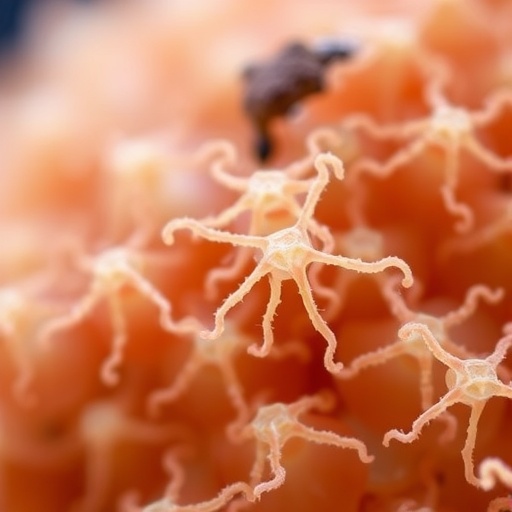In the relentless battle against antifungal resistance, the research spearheaded by Zapadka et al. offers a significant breakthrough through the development of an Interpretable Quantitative Structure–Activity Relationship (QSAR). This innovative approach focuses on identifying potent agents that can combat the notorious pathogen, Candida albicans, known for its contribution to severe infections, particularly in immunocompromised individuals. The research targets not only the fundamental understanding of how chemical structures correlate with their biological activity but also emphasizes the importance of interpretability in QSAR models, which can greatly enhance the applicability of these findings in clinical settings.
Candida albicans serves as a model organism, particularly due to its prevalence in human infections, and represents a substantial challenge in the realms of pharmaceutical research and clinical hygiene. The high rates of antifungal resistance observed in C. albicans necessitate the discovery of new antifungal compounds that can effectively bring down the threat posed by these resistant strains. Conventional methods of antifungal screening often fall short in providing a clear path towards the identification of new therapeutic agents. This research addresses this gap by employing QSAR analyses, which utilize data on the chemical structure of compounds to predict their biological activity.
The QSAR methodology utilized by Zapadka and colleagues leverages advanced computational techniques, including machine learning algorithms, to analyze and model the various chemical properties associated with antifungal activity. The integration of these computational models allows researchers to screen vast libraries of compounds rapidly, pinpointing those that exhibit the most potential in combating C. albicans. This data-driven approach not only accelerates the drug discovery timeline but also paves the way for more targeted and effective therapeutic strategies.
One of the key highlights of their study is the focus on interpretability. In the realm of chemical sciences, where complex models may obfuscate rather than clarify, the researchers have taken meticulous efforts to ensure that the QSAR models can be interpreted with ease. By elucidating the relationship between chemical structure features and antifungal activity, they provide insights that can guide chemists in designing new compounds that are not only potent but also bear structural resemblance to their successful counterparts.
Moreover, the study emphasizes a collaborative framework whereby the integration of data across various disciplines, including pharmacology, chemistry, and bioinformatics, is crucial. By fostering an interdisciplinary approach, the identification of antifungal agents can become more robust, leading to innovative solutions that address the multifaceted challenges posed by fungal infections. This collaborative effort heralds a new era in drug development where computational predictions are validated through experimental work.
The results gleaned from the QSAR models further reveal critical insights into which molecular features contribute positively or negatively to antifungal activity against C. albicans. Understanding these structural characteristics can aid chemists in rational drug design, where they can modify existing compounds or synthesize new ones with enhanced efficacy. This pathway toward rational drug design holds great promise in not only addressing immediate therapeutic needs but also in thwarting potential future resistance derivatives.
Furthermore, the study sheds light on the necessity for ongoing research into the dynamics of fungal resistance mechanisms. As C. albicans evolves, understanding the corresponding changes in its susceptibility profiles in response to new antifungal agents becomes paramount. Thus, the findings from the QSAR models present an invaluable foundation towards more dynamic and adaptable treatment regimens, tailored to counteract the ever-evolving nature of pathogens.
Amidst the frenzy of modern medicine, the findings of Zapadka et al. highlight a critical aspect of drug discovery: it is not solely about efficacy but about a thorough understanding of how and why certain compounds exert their effects. By fostering transparency within QSAR models, their research encourages further inquiry and validation in the scientific community, potentially leading to a wealth of new antifungal agents entering the clinical pipeline.
The interplay between structure and activity also extends into discussions on synthetic accessibility and environmental impact. As the research community grows increasingly aware of the implications of drug production on the environment, understanding the relationship between chemical structures and their synthesis becomes essential. QSAR models not only afford insights into biological effectiveness but can help streamline the production process, thereby aiming to reduce waste and energy expenditure in the development of new therapeutics.
As this exciting research unfolds, other scientists are encouraged to further explore the breadth of QSAR methodologies, employing interpretative frameworks that enhance their studies while also ensuring that their findings are accessible and comprehensible to wider audiences. The sharing of knowledge across various platforms fosters a collaborative atmosphere that nurtures innovation and progressive breakthroughs in the field of medicinal chemistry.
Research outcomes like those presented in the article serve to propel forward the field of pharmacology, offering not just hope but a tangible pathway toward the next generation of antifungal therapies. The anticipated implications of this study extend beyond academic curiosity, aiming to translate findings into effective treatments that can be administered in clinics worldwide as the battle against fungal infections continues.
The overarching narrative asks not only what lies within the realm of potential new drugs but also how science can unite to craft solutions to real-world health challenges. As researchers, clinicians, and pharmaceutical scientists converge in their efforts, the promise of safe, effective, and accessible antifungal treatments becomes a beacon of hope for many suffering from fungal diseases.
As this vital research is rolled out, it beckons a call to action for both established scientists and budding researchers, inviting them to delve into the intricacies of QSAR models and their robust applications in drug discovery. The road ahead appears promising, urging biomedical science toward greater insights and breakthrough innovations in the face of increasingly complex health challenges.
Thus, as we explore these new landscapes of discovery, we are reminded that each study not only builds upon its predecessors but sets a foundation for generations of researchers who will follow. The advancements in understanding structure-activity relationships mark a pivotal moment in the ongoing quest for better health outcomes, particularly for those afflicted by formidable fungal pathogens.
Subject of Research: Development of an Interpretable Quantitative Structure–Activity Relationship (QSAR) model to identify antifungal agents against Candida albicans.
Article Title: Interpretable Quantitative Structure–Activity Relationship (QSAR) for identification of potent antifungal activity agents towards Candida albicans ATCC 2091.
Article References:
Zapadka, M., Łączkowski, K.Z., Budzyńska, A. et al. Interpretable Quantitative Structure–Activity Relationship (QSAR) for identification of potent antifungal activity agents towards Candida albicans ATCC 2091. Mol Divers (2025). https://doi.org/10.1007/s11030-025-11404-2
Image Credits: AI Generated
DOI: https://doi.org/10.1007/s11030-025-11404-2
Keywords: Antifungal, Candida albicans, QSAR, drug discovery, structure-activity relationship, machine learning, pharmacology, interpretability, drug resistance.
Tags: antifungal resistanceantifungal screening methodsCandida albicans infectionschemical structure and biological activityclinical application of QSAR findingsimmunocompromised individuals and infectionsInterpretable Quantitative Structure–Activity Relationshipnovel antifungal compoundspharmaceutical research challengespotent antifungal agentsQSAR models in drug discoveryresistant fungal strains





